To make herb-infused oil soaps, you'll need to start by creating your infused oils using dried herbs and a carrier oil through either solar or heat infusion methods. Pack your chosen dried herbs in a clean jar, cover completely with oil, and infuse for 4-6 weeks on a sunny windowsill or 2-3 hours using a water bath. Once you've strained your infused oils, combine them with lye and distilled water following basic cold process soap making techniques. There's so much more to explore about customizing your natural soap creations.
Understanding Herbal Oil Infusion Basics
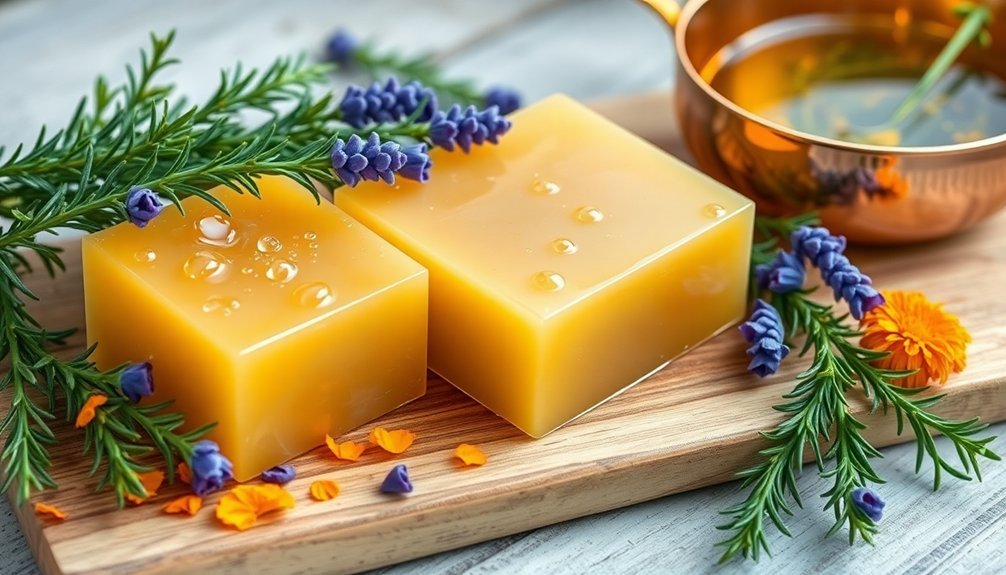
While making herbal-infused soaps may seem complex at first, understanding the oil infusion process is straightforward. You'll need to select the right herbs and combine them with your chosen carrier oil to create a herb-infused oil that's perfect for soap using.
Always opt for dried herbs over fresh herbs when making infusions, as fresh plant material can lead to mold growth and spoilage.
You'll want to guarantee your herbs stay completely submerged in oil throughout the infusion process, which can take anywhere from 4 hours to 6 weeks, depending on your method.
If you're short on time, you can speed up the process using heat methods like a slow cooker or water bath. This controlled heating will help extract the beneficial properties and natural colors from your herbs more quickly.
Essential Tools and Materials Needed
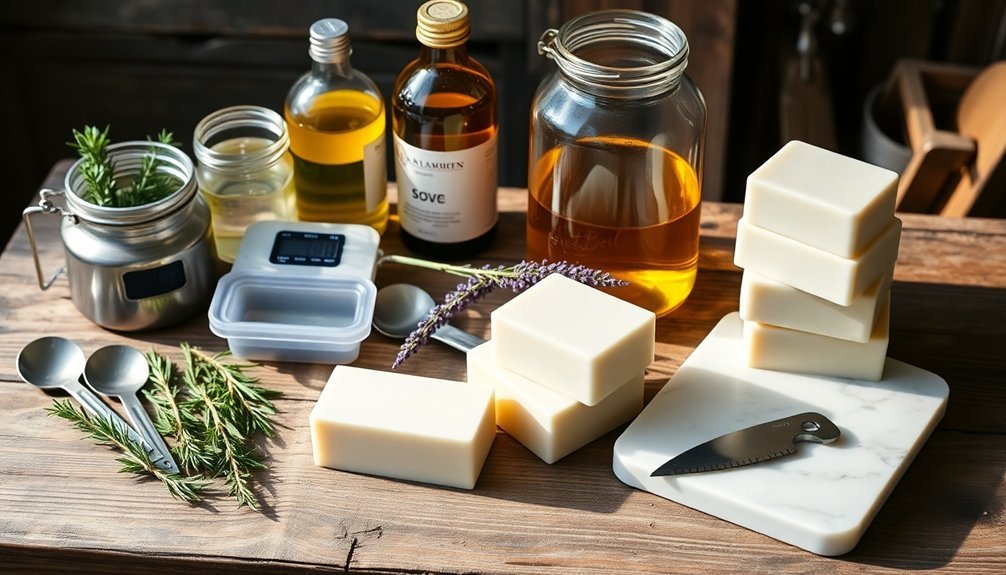
Before starting your herb-infused soap-making journey, you'll need to gather the right tools and materials to guarantee success. The essential tools include a digital scale for precise measurements, a thermometer to monitor temperatures, and an immersion blender for thorough mixing.
You'll need stainless steel or heatproof glass containers for both your lye solution and soap batter. Don't forget safety equipment like gloves and goggles.
For creating infused oils, collect clean, sterile jars suitable for both slow and quick infusion methods. Choose long-lasting base oils like olive oil for your herbal infusions.
Stock up on dried herbs for infusion, distilled water for your lye solution, and any optional additives you'd like to incorporate. These might include essential oils or natural colorants to customize your final product.
Selecting the Right Herbs for Soap Making
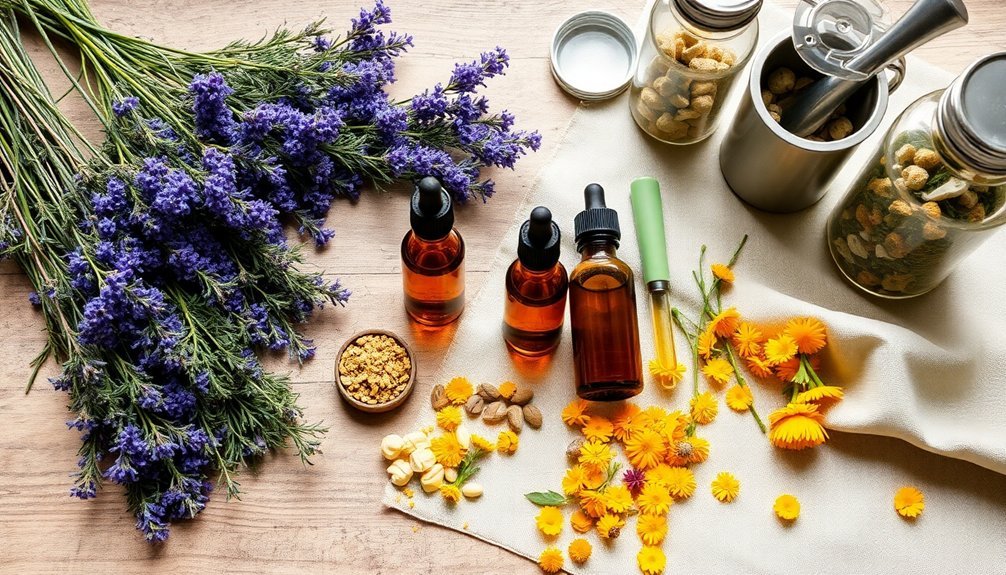
Choosing the right herbs for your soap-making venture can dramatically enhance both the therapeutic value and aesthetic appeal of your final product. To successfully herbs infuse your soaps, you'll want to focus on dried herbs rather than fresh ones to prevent mold and guarantee longer shelf life. Consider herbs known for their skin benefits, like soothing chamomile or calming lavender. Before using any herb, perform a patch test to ascertain skin compatibility.
| Herb | Color | Benefits |
|---|---|---|
| Chamomile | Light Yellow | Soothes Skin |
| Lavender | Purple | Calms Mind |
| Peppermint | Green | Invigorates |
| Turmeric | Golden | Brightens |
Remember to pair complementary scents, like peppermint with eucalyptus, for an energizing experience. Natural colorants like alkanet and turmeric can create vibrant hues without the graininess of artificial powders.
Solar Infusion Method Step-by-Step
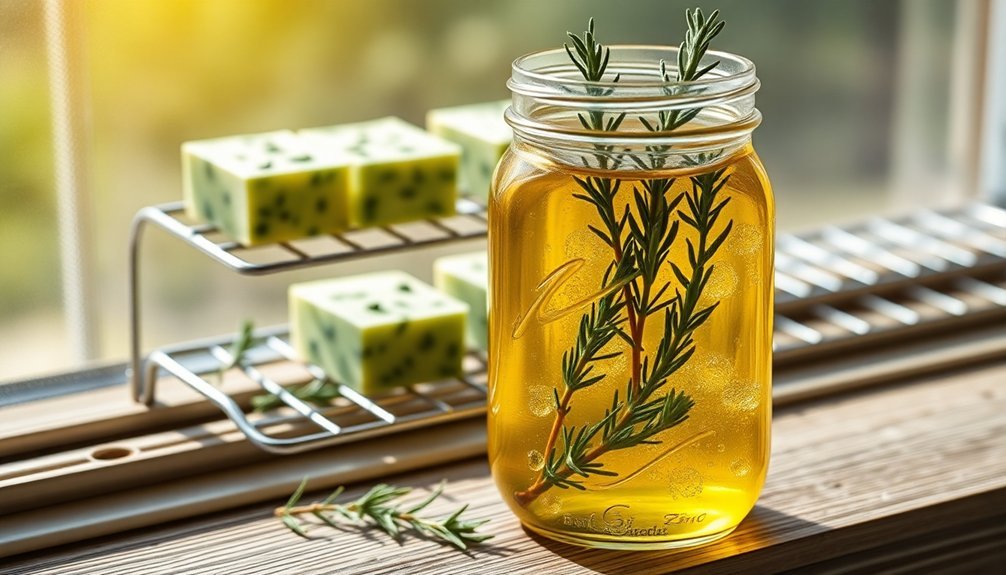
Now that you've selected your herbs, the solar infusion method offers a natural way to extract their beneficial properties into carrier oils.
To begin the solar infusion method, pack your wilted or dried herbs tightly into a clean jar, then pour your chosen carrier oil until it completely covers the plant material.
Label your jar with essential details, including the date and ingredients used. Place the jar on a sunny windowsill, where it'll infuse for 4-6 weeks.
Don't forget to shake your jar daily to guarantee the herbs stay submerged and their properties distribute evenly throughout the oil.
After the infusion period, strain the mixture through a fine sieve or cheesecloth to remove all plant material.
Store your herb-infused oils in a cool, dark place or refrigerate them until you're ready to make soap.
Quick Heat Infusion Technique
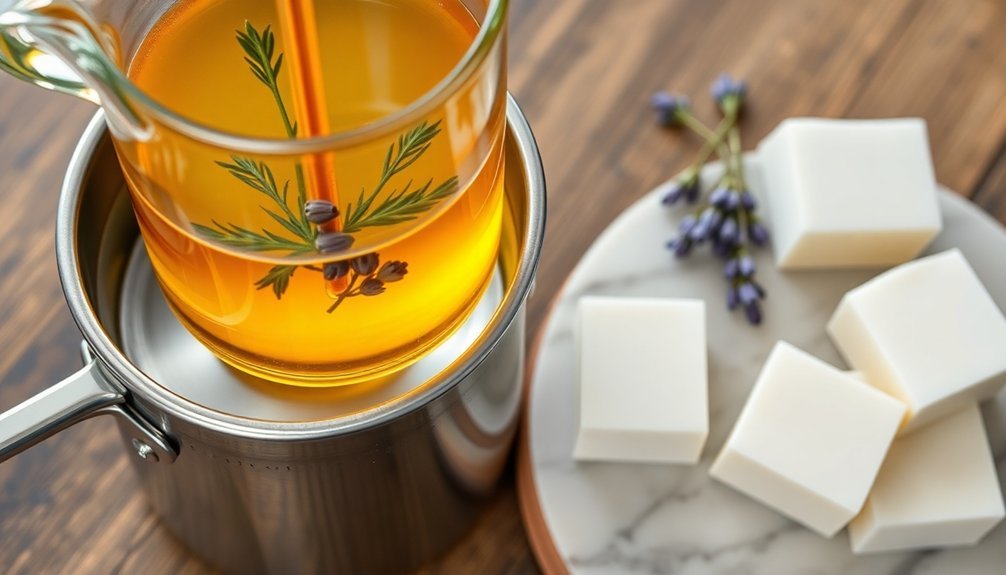
When time is of the essence, the quick heat infusion technique provides a faster alternative to the solar method while still capturing the herbs' beneficial properties.
To start infusing oils for your natural soaps, place your chosen dried herbs in a jar and cover them with oil. Create a water bath by placing the jar in a pot of water, then heat gently for 2-3 hours.
For the best results when making herbal soap, follow these key steps:
- Use heat-sealable tea bags to contain powdered herbs, making straining easier
- Monitor water levels consistently to maintain proper heating temperature
- Allow the infused oil to cool completely before straining
- Strain through a fine sieve or muslin cloth for clear, vibrant results
This technique is perfect for creating colorful, naturally-infused soaps without unwanted graininess.
Proper Storage of Infused Oils
The three main factors that can quickly degrade your infused oils are heat, light, and air exposure. To maintain the quality of your oils, you'll need to store them properly in airtight glass containers, away from direct sunlight and heat sources.
When storing your infused oil, always label each container with the type of herbs used, the base oil, and the infusion date. This practice helps you track freshness and potency.
Glass containers are essential since plastic can interact with the oils and compromise their quality. For maximum shelf life, keep your unused infused oils in the refrigerator, especially those made with fresh herbs.
Don't forget to check your stored oils regularly for signs of spoilage. If you notice any unusual odors or cloudy appearance, it's time to discard them.
Basic Cold Process Soap Recipe
Creating a basic cold process soap starts with three essential components: distilled water, sodium hydroxide (lye), and your chosen blend of oils or butters.
When making cold process soap, you'll need to combine these ingredients in a 1:3 lye-to-oil ratio by weight.
Key steps for successful soap making:
- Cool your lye solution for 30-40 minutes while warming your oils to match temperatures
- Blend the lye solution into your oils until you reach "trace" – a pudding-like consistency
- Pour the mixture into your mold and cover it for 1-2 days
- Allow your soap to cure for 4-6 weeks before use
You can enhance your cold process soap by incorporating herb-infused oils into your recipe.
These special oils won't only add natural color but also bring beneficial properties to your final product.
Blending Infused Oils in Soap Making
Successfully blending herb-infused oils into your soap requires careful consideration of both ratios and oil selection.
Creating effective herb-infused soaps demands precision in measuring oils and selecting compatible ingredients for optimal results.
When creating Natural Soap, you'll want to choose stable base oils like olive oil that won't compromise your soap's longevity. Different methods of infusing herbs can affect your final product's color and therapeutic properties.
For best results, limit your infused oils to 10-25% of your total oil weight. This guarantees you'll get the benefits and color you're looking for without overwhelming your soap's formulation.
Before blending infused oils into your recipe, check their strength and color intensity. You can adjust infusion times to achieve your desired results.
Remember that some herbs will produce more vibrant colors than others, so choose your infusion combinations carefully to match your soap-making goals.
Natural Colorants From Herb Infusions
Natural herb infusions offer soap makers three key advantages when it comes to coloring: vibrant hues, smooth texture, and enhanced therapeutic benefits.
When you're creating infused oils for soap making, you'll find that natural colorants from herbs provide rich, lasting colors without the graininess often found in powdered additives.
- Alkanet-infused oil creates beautiful purple tones
- Turmeric infusions yield bright yellow shades
- Paprika produces rich red hues
- Extended infusion time increases color intensity
You can monitor and adjust your infusions to achieve your desired shade, either by heating longer or allowing more steeping time.
When incorporating these infused oils into your soap recipes, you'll replace a portion of your base oils, ensuring both color stability and the added skin-nourishing properties of your chosen herbs.
Safety Measures and Best Practices
While herb-infused soaps offer wonderful benefits, prioritizing safety measures guarantees a secure and successful soap-making experience.
You'll need to protect yourself by wearing gloves and goggles when handling lye, as it can cause severe burns to your skin and eyes. Work in a well-ventilated space to avoid inhaling dangerous fumes during the mixing process.
When working with natural oils and essential oils, store them safely away from children and pets.
You'll want to monitor heat levels carefully during oil infusion to maintain quality and prevent overheating. Always use heat-resistant containers for your lye solutions and infused oils to avoid accidents.
These safety measures aren't just precautions – they're vital steps that protect you and guarantee your herb-infused soaps turn out perfectly every time.
Troubleshooting Common Issues
Even experienced soap makers encounter challenges when working with herb-infused oils, but most issues have straightforward solutions.
When you use fresh herbs, remember they're not shelf-stable, so it's essential to monitor the infusion process carefully and use them immediately.
To avoid common problems in your herb-infused oil soap, follow these key guidelines:
- Make sure your herbs remain fully submerged in oil during infusion to prevent mold growth.
- Strain your infused oil thoroughly through a fine sieve or cheesecloth to avoid grainy textures.
- Watch infusion timing closely – over-infusing can result in undesirable colors or flavors.
- If you're not getting the desired color in your soap, try adjusting infusion temperature or duration.
You'll achieve better results by paying attention to these details and making adjustments as needed during the soap-making process.
Creative Recipe Variations and Combinations
Ready to take your herb-infused soap making to the next level? Let your creativity flow by experimenting with exciting herb combinations that deliver both aromatic pleasure and therapeutic benefits.
Try pairing lavender with chamomile for a relaxing blend, or combine rosemary and mint for an energizing experience.
Maximize skin benefits by incorporating infused oils at trace, ensuring their properties remain intact. You'll enhance your soaps by combining complementary ingredients, such as calendula-infused oil with tea tree essential oils for a cleansing yet gentle bar.
For an advanced technique, try double infusion by using one infused oil as the base for another – like combining chickweed with plantain for extra skin-soothing properties.
Don't forget to explore natural colorants like alkanet or annatto, which add both visual appeal and beneficial properties to your creations.
Frequently Asked Questions
How to Infuse Herbs in Oil for Soap Making?
You'll need to submerge dried herbs in oil using a 2:5 tablespoon-to-ounce ratio. Either let it sit in sunlight for 2-6 weeks, or heat in a water bath for 2-3 hours, then strain.
How to Make Homemade Herbal Soap?
First, infuse your oils with herbs. Mix lye and water separately, then blend with warmed oils until reaching trace. Add essential oils, pour into molds, and let cure for 4-6 weeks before using.
How Do You Make Herbal Infused Oil at Home?
Place dried herbs in a clean jar, cover with olive oil, and either let it sit on a sunny windowsill for 4-6 weeks, shaking daily, or heat in a water bath for 2-3 hours. Strain when done.
How Do You Avoid Botulism in Infused Oil?
You'll prevent botulism by using only dried herbs, not fresh ones. Store your infused oils in a cool, dark place, use sterilized equipment, and consume within months. Consider adding acidic ingredients like lemon juice.
In Summary
You've now mastered the art of creating beautiful herb-infused oil soaps from scratch. Don't be afraid to experiment with different herb combinations and infusion methods to develop your signature blends. Remember to always follow safety protocols and document your successful recipes. Whether you're using solar or heat infusion, you'll find that crafting these natural soaps becomes easier and more rewarding with each batch.

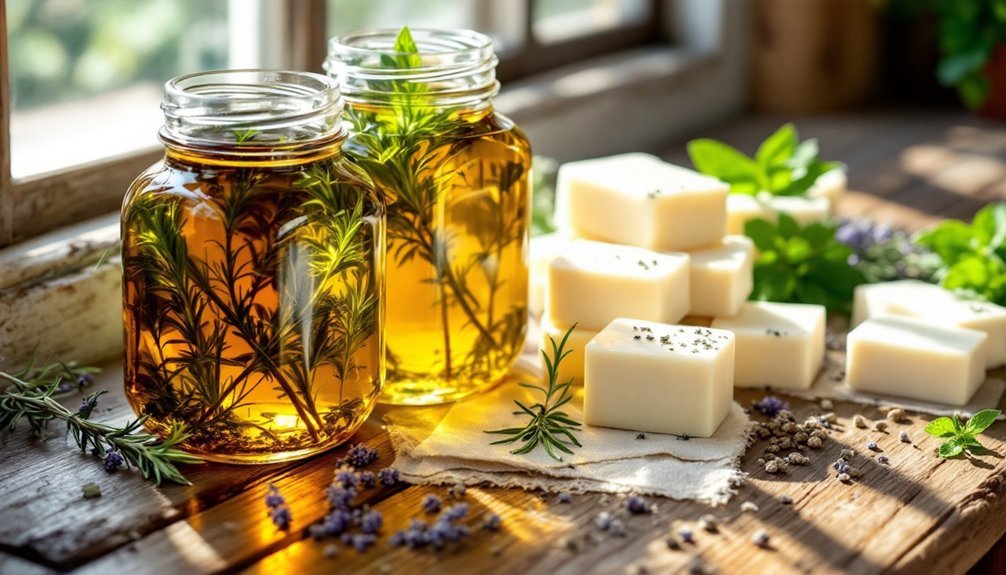



Leave a Reply